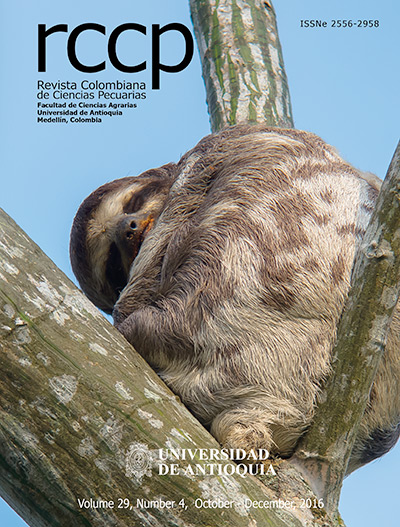Estado oxidativo e fertilidade nas ovelhas suplementadas com a polpa de café durante sincronização do estro e gestação inicial
DOI:
https://doi.org/10.17533/udea.rccp.325037Palavras-chave:
capacidade antioxidante, CIDR, oxidação, progesteronaResumo
a polpa de café pode modificar o estado oxidativo e a fertilidade em vacas leiteiras. Objetivo: avaliar a polpa de café na capacidade antioxidante, oxidação da gordura e nas características reprodutivas das ovelhas durante sincronização do estro e gestação inicial. Métodos: quarenta ovelhas cruzas Suffolk e Dorset de 3 e 4 nascimentos foram agrupadas no T0 (n = 21), suplementação com 450 g de alimento controle e T1 (n = 19), suplementação com 450g de alimento com 25% de polpa de café. A suplementação iniciou 14 dias antes da sincronização do estro e terminou 25 dias depois do acasalamento. O hormônio progestina (CIDR, dispositivo intravaginal de libertação controlada de fármaco) foi inserido por 11 dias. Dezoito horas depois da retirada iniciouse a detecção do estro. Fizeram-se amostras de diferentes tempos do período e da gestação inicial para determinar a capacidade antioxidante, oxidação dos lipídeos e concentração de progesterona. Realizou-se o diagnóstico de gestação 30 e 60 dias depois de remover o CIDR. Resultados: a suplementação com a polpa de café não afetou o início do estro, a resposta ao estro e a concentração de progesterona, mas a fertilidade decresceu de 100 a 78,95%. A capacidade antioxidante que foi medida pela técnica de FRAP foi maior nas ovelhas suplementadas com a polpa de café somente antes da inserção do progestágeno. A polpa de café não modificou a oxidação dos lipídeos; no entanto, estes foram modificados pelo tempo de amostra, decrescendo depois de remover o progestágeno até 22 dias de gestação. Conclusão: ainda que a polpa de café a 25% de concentração incrementa a capacidade antioxidante antes da inserção do progestágeno, não é recomendado este percentual para as ovelhas durante a sincronização do estro e a gestação inicial, já que decresce a porcentagem de gestação.
Downloads
Downloads
Publicado
Como Citar
Edição
Seção
Licença
Os autores autorizam a RCCP a reimprimir o material nela publicado.
A revista permite que o(s) autor(es) detenham os direitos autorais sem restrições, e permitirá que o(s) autor(es) mantenham os direitos de publicação sem restrições.






